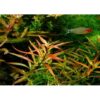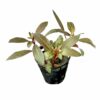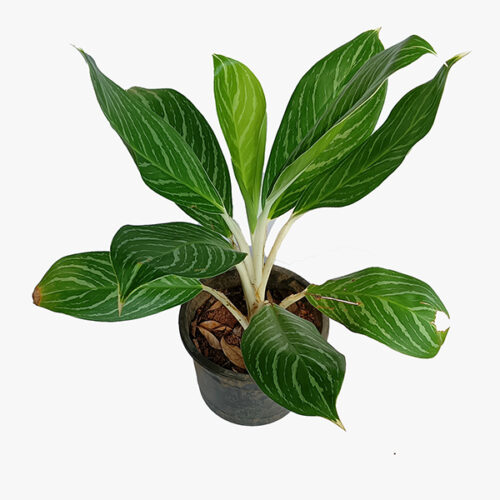Ludwigia arcuata [Tc] is a lovely plant with delicate green and red foliage. This is a simple to care for plant that adds movement and dimension to the aquarium. Needle leaf plants have thin, pointed leaves that grow in opposite pairs down the stem. Depending on the amount of iron in the water, the leaves can be green or red. This plant will branch out and provide a bushy filler for the mid- or background of your tank if pruned frequently. Needle leaf is a versatile plant, but to achieve the desired bright red colour, high lighting and nutrient levels are required. A high iron content will highlight the plant’s red tones. CO2 injection is not required for the cultivation of this plant, but it can aid in its growth. The plant can be grown in either submerged or emersed conditions. When grown emersed, the leaves are round and green, similar to other types of Ludwigia. When grown in a high-light environment and submerged in an aquarium, the leaves become thin and orange to red, depending on the nutrients. The deep red coloration will be enhanced by taking UNS Plant and iron supplements. Plants can be propagated by taking cuttings from the main stem and replanting them in the substrate.
Ludwigia arcuata is a delicate stem aquatic plant native to the United States. It is frequently confused with Ludwigia brevipes, which is similar but larger and has broader leaves. It is also related to Didiplis diandra, which is much more difficult to cultivate. Ludwigia arcuata has orange-reddish leaves with thin stems and leaves.
Ludwigia arcuata [Tc] can tolerate a wide range of water parameters and is a simple background aquarium plant to grow as long as it gets enough light and nutrients. With nitrate limitation, this stem plant turns much redder.Ludwigia arcuata [Tc] can be aggressively pruned. This promotes the formation of side shoots, and the plant can become very bushy as a result. It is quite resistant to dense growth and can be pruned for many weeks without needing to be replanted. Because of its fine texture, it can be used as a mid/background aquarium plant in smaller tanks.
Important success factors:
adequate lighting (medium onwards)
Avoid using water with extreme parameters.
CO2 fertilisation is required for good growth.
How to make it more red:
A brighter light (higher PAR values)
Increased red/blue light spectrum
It becomes significantly redder when nitrate levels are low.
This is one of the plants that grows much redder when nitrates are limited – that is, the plant grows much redder when nitrates are limited. If you overdo it, the plant will stunt. However, because it is tolerant of much lower nutrient levels than other plants, it usually stunts first.
Trimming:
Remove the plant’s top a few inches below the final desired height. To fill in the gaps, side shoots will sprout from the remaining bottom portion. Trim away faster growing shoots that poke above the rest as the side shoots form. You will eventually have a nicely contoured bush.
If there is a lot of light and empty space, this stem plant will grow sideways. Planting them more densely at first – 1.5cm apart – will encourage them to grow more vertically.
In general, the Ludwigia arcuata [Tc] is a low-maintenance plant that requires moderate to high lighting, basic fertilisation, and can be grown emersed or submerged. It’s a good plant for a beginner who is just getting started with their aquarium and doesn’t want any plants that require a lot of attention.The ludwigia arcuata thrives in moderate to high lighting, though it will turn redder in brighter conditions. It grows best at temperatures ranging from 20 to 28 degrees Celsius (68 to 82 degrees Fahrenheit) and pH levels ranging from 5.5-8. These are both standard levels for most aquariums, so just keep an eye on your aquarium to ensure it stays within these parameters.The ludwigia arcuata grows slowly, so regular pruning and propagation can help. This will encourage it to grow fuller and bushier, making it more appealing in your aquarium.
How do you grow Ludwigia arcuata [Tc] in a tank?
While the ludwigia arcuata appears delicate, it is actually very hardy and simple to grow. Place the stem of a ludwigia arcuata directly into the substrate at the bottom of an aquarium to plant it. This plant can be grown in any standard aquarium substrate.Because this is a slow-growing plant, regular pruning can help promote growth. You can also propagate the plant by taking cuttings. Simply cut a section of the stem from the last node and replant it in the substrate. This can help you achieve a bushier, fuller appearance in your tank.
Is it possible to grow Ludwigia Arcuata emersed?
Depending on your end goal and how you want your ludwigia arcuata to look in the tank, there are several ways to grow it. A ludwigia arcuata can be grown emersed, resulting in round, green leaves growing above the water’s surface. To grow it emersed, plant it in a substrate that is submerged in water but the foliage remains above the water line. This is ideal for a terrarium.Ludwigia arcuata can also be grown submerged, which results in thinner leaves that, under the right conditions, can turn yellow, orange, and eventually a deep red. Consider how you want your fish tank to look, and then decide whether you want to plan your ludwigia arcuata emersed or submerged.Because these plants are also relatively easy to propagate, you may choose to grow new plants from cuttings and replant them in new substrate, allowing the ludwigia arcuata to grow in different areas of the tank.
How do you get Ludwigia arcuata [Tc] to grow dark red?
While green leaves are appealing, one of the main reasons to plant a ludwigia arcuata in your fish tank is to obtain the stunning deep red colour. This adds a lot of visual appeal to your fish tank.The ludwigia arcuata requires red/blue light spectrum exposure, high light levels, and low nitrates to grow dark red. Make sure you have a light with a high PAR value if you want stronger light. You can also look for a light with a more concentrated red/blue light spectrum. This will assist in achieving optimal lighting conditions for your Ludwigia arcuata to mature into a deeper red.Limiting the nitrates that a Ludwigia arcuata [Tc] receives is another way to promote its dark, deep red colour. To encourage the development of red leaves, make sure you are not over-fertilizing with nitrates.
Requirements for Lighting
To achieve optimal growing conditions, the ludwigia arcuata requires medium light levels of 35-50 PAR. Because high light is not required, it is a relatively simple plant to grow and maintain. When buying aquarium lights, make sure to check the PAR and make sure it matches the light requirements of your plants.If you have a mix of low, medium, and high-light plants in your aquarium, it will be difficult to keep them all alive. Because ludwigia arcuata is a medium-light plant, it should be kept in a tank with other medium-light plants that require 35-50 PAR.
Temperature
It is critical to have the proper temperature for optimal growing conditions. The ludwigia arcuata can withstand temperatures ranging from 68 to 82 degrees Fahrenheit (20–28 degrees Celsius). This temperature is within the normal range for most fish tanks, which is usually in the low 70s (°F).So, as long as you check the temperature of your tank on a regular basis to ensure it is within this range, you will have optimal growing temperature for your ludwigia arcuata.
pH of water
The Ludwigia arcuata requires a pH range of 5.5-8, which is typical of a fish tank’s maintenance range. Because the pH of an aquarium will become more acidic over time due to organic material dissolving and breaking down, it is critical to check the pH level of your tank on a regular basis.The best way to keep it stable and prevent it from dropping too low is to change the water, clean it on a regular basis, and prepare your water with calcium carbonate substrates, which will buffer the pH.
Conclusion
There’s a reason why ludwigia arcuata is such a popular aquatic stem plant! It’s simple to grow and care for, and it adds vibrant foliage to your tank. It has a diverse appearance that both you and your fish will enjoy because it can grow emersed or submerged and takes on colours of green, yellow, and red.


![Ludwigia arcuata [Tc]](https://elysianflora.com/wp-content/uploads/2021/12/plant_05-1.jpg)






Reviews
There are no reviews yet.